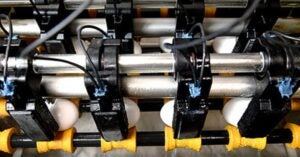The Centers for Disease Control and Prevention estimates Salmonella bacteria causes about 1.35 million infections, 26,500 hospitalizations, and 420 deaths in the United States every year.
Despite their appearance in everyday meals and snacks, raw eggs and egg products can carry Salmonella and cause foodborne illness, outbreaks, and even death in some circumstances. However, researchers at the U.S. Department of Agriculture recently found a way to combat this through Radio Frequency technology.
A simple solution to foodborne pathogens in eggs would be to pasteurize all raw eggs before they are consumed, but less than 3 percent of commercial eggs are pasteurized in the United States. Conventional thermal pasteurization of intact eggs is usually a long process that involves submerging eggs in hot water for more than 57 minutes to inactivate Salmonella cells. Researchers at the Agricultural Research Service’s Eastern Regional Research Center in Wyndmoor, Pennsylvania, used a novel thermal technology that pasteurizes eggs and inactivates Salmonella cells with a short processing time.
During the study, the water molecules inside the egg rotate and align with the RF instrument’s electric field. This molecular friction causes the liquid inside the egg to heat up quickly and subsequently reduce Salmonella by 99.999 percent within 24 minutes. The R.F.-processed eggs were transferred to the refrigerator and kept at 7°C for seven days to simulate the commercial cold chain temperature.

“After treatment with the system, no intact Salmonella or sub-lethal Salmonella cell remnants were recovered, and no cell recovery was found in the R.F. – treated eggs when stored at retail refrigerated temperature,” said USDA-ARS Research Food Technologist Daniela Bermudez-Aguirre. “The egg quality, such as the color and other parameters, were also preserved through the processing.”
This technology has shown several advantages when used in food, all without a negative effect on food quality. Statistics also show that Americans consumed a total amount of 93.1 billion eggs in 2023. So, this is a promising advancement for small farmers or egg processors and can ensure food-safe eggs while minimizing Salmonella.

